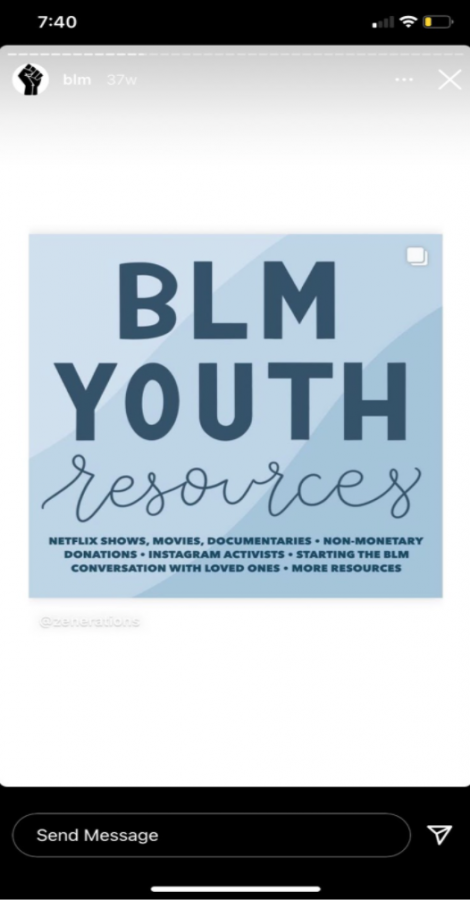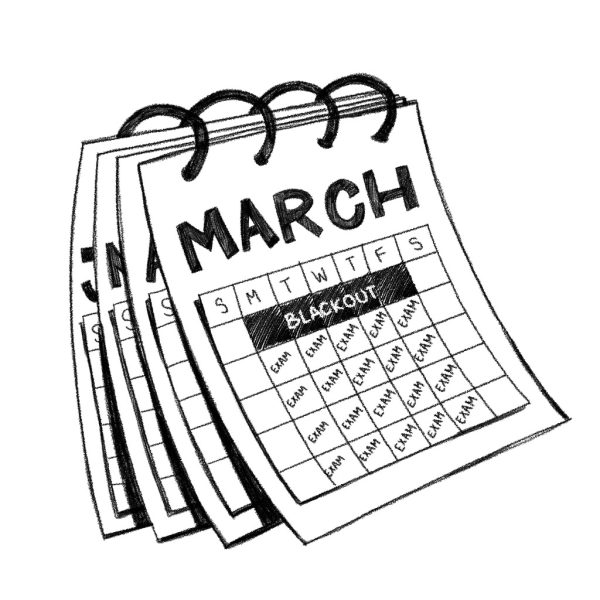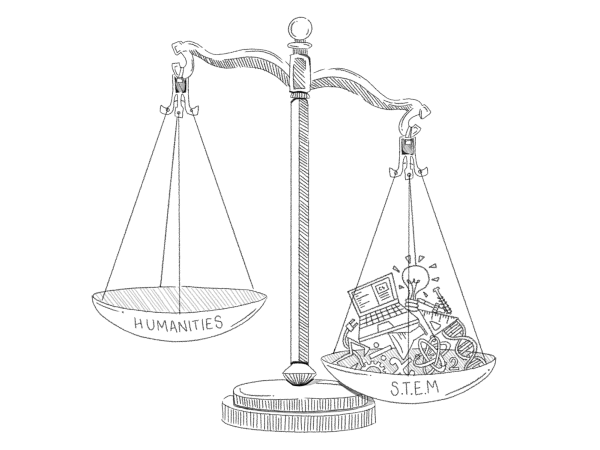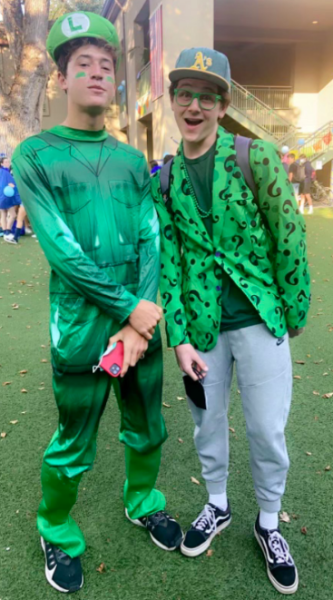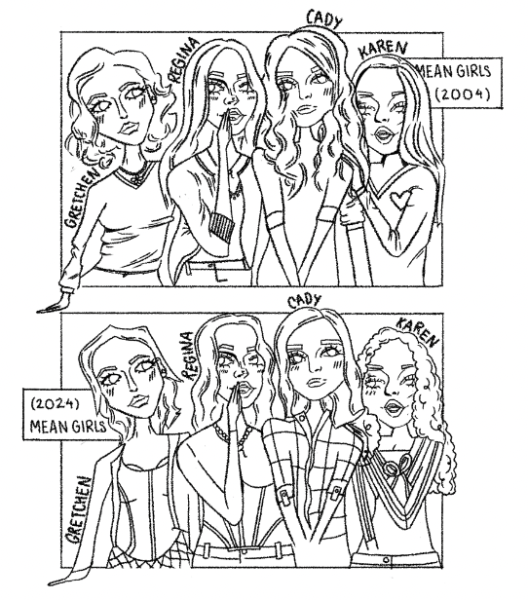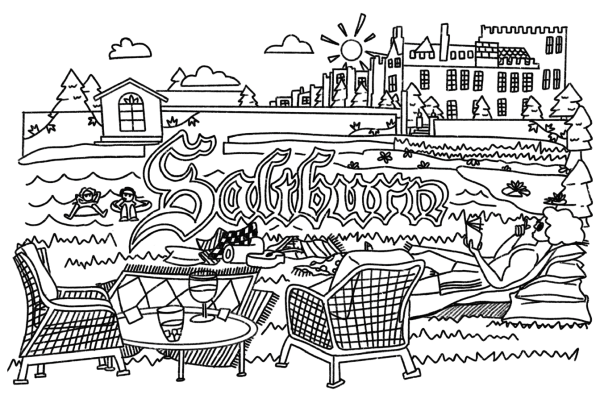Menlo Students Stand Up For Injustices On Social Media
An Instagram story directs people to an educational post with resources to help support and spread awareness around the Black Lives Matter movement. Photo courtesy of Maya Debnath.
June 8, 2021
Every time I log onto Instagram, I see a plethora of stories and hashtags concerning current injustices in the world. In July 2020, according to the Pew Research Center, 36% of social media users had shown their support for a social or political cause on a digital platform. Some of the most popular hashtags and movements of 2020 and 2021 include the Black Lives Matter movement, campaigns supporting the Australian fires, the movement to end Asian hate and the Me Too movement.
People have used social media to spread information, educate themselves and raise awareness about world issues. According to Maryville University, activism on social media has helped promote publicity, raise awareness about important issues and inspire change. According to NPR, one of the first instances of cumulative social media activism was the Occupy Wall Street Movement in September of 2011, which advocated for economic equality. The Black Lives Matter movement is also an older hashtag that began in 2013 and snowballed into an enormous and impactful movement.
Later, social media activism became a more common form of advocacy, and people used it to address many serious issues. For example, in February of 2018, in the wake of the Marjory Stoneman Douglas School shooting, the March for Our Lives movement was created by a group of passionate activists to minimize school shootings. The campaign took off on social media with the popular hashtag #MarchForOurLives. Activists successfully organized a national school walkout, and people shifted the use of their social media accounts to spread information about the walkout so that the movement would gain more publicity.
Though public displays of activism don’t always spark immediate change, they increase the probability of important issues reaching people in positions of power so that change can be made. Social media activism has even reached Menlo, inspiring students and staff to participate in an all-school walkout against gun violence in solidarity with other schools across the country in 2018. Sophomore William Floyd was on the board of organization of the Menlo middle school walkout. “I feel strongly that school should be a safe and fun environment for kids, not a lethal one, so when I saw on Instagram that there was a national school walkout, I approached [Head of School Than Healy] to ensure Menlo participated,” Floyd said.
Online activism on social media helped spread publicity about the walkout, resulting in widespread participation and concrete action with the creation of the Aid and Alliance Program in response to the walkouts. The Aid and Alliance Program focuses on anti-violence work and donations. According to the March For Our Lives campaign, it donated 500,000 dollars to support anti-gun violence.
Social media activism also raised awareness and money for the massive fires in Australia, some of the largest to ever burn according to The New York Times, that lasted from 2019 to 2020. Support for fire relief went viral on social media, and many people posted pictures of the natural disaster on their stories to highlight its severity. I remember seeing pictures with captions of statistics portraying the magnitude of the fires, and it was utterly heartbreaking. This helped capture the devastation of the disaster, encouraging my friends and me to help. At Menlo, tables were opened where students could write notes to those affected by the fires in Australia and donations were encouraged. A few of my friends donated to GIVIT, a program they discovered through social media that gives back resources to those affected in the fires. According to BBC, there was a hashtag created called #GoWithEmptyEskies, referring to travelling with empty water bottles, which encouraged thousands of social media users to travel to blazed areas once the fires ended so they could spend money on hotels, food, fuel and other materials to help local economies during the crisis.
One widespread issue that has gained popularity on social media is sexual assault. According to the Quebec National Institute of Public Health, media coverage of cases increases awareness and creates a safe environment that encourages more women to come forward. Though posting on social media doesn’t spark immediate change, it helps some students feel safer and more empowered about specific world issues. “As a woman, I feel unsafe walking at night, and I resent that […] I will continue to post on my Instagram story to speak out against sexual assault and advocate for the safety of women,” sophomore Maya Debnath said.
Currently, there has been a lot of activism and outrage on social media about racial issues and injustices. According to The Guardian, after the death of George Floyd in May 2020, the Black Lives Matter movement gained a lot of traction on social media. Hashtags and online movements were created to advocate for change, including the Say Their Name campaign that advocated against police brutality towards Black people, and the Blackout Tuesday trend where people posted blank black screens using #Blackout Tuesday to raise awareness about the issues of racism in our society. People posted in mass about BLM as a widespread display of recognition and mutual understanding of the injustices facing society, and it took over social media feeds. According to the Washington Post, people of color have attempted to use social media to educate white people about their personal experiences with racism in society. “After the George Floyd incident, all I saw on my feed were BLM protests, posters, black screens and pictures, which all helped educate me on the issues of racism in our society that I wasn’t previously aware of,” freshman Maddie Brown said.
According to the New Yorker, activists organized many BLM protests and posted the protest information on social media, resulting in an increase in attendance, and therefore a louder, stronger voice to advocate for change. According to Business Insider, after the mass display of outrage from society, reforms were put into place that outlawed chokeholds in California, Texas, Washington and Nevada, and have forced police officers to wear body cameras. This was just one display of the productivity of cohesive social media demonstrations in raising awareness and sparking simple change through laws and reforms.
Social media provides people with a platform to speak out about issues they are passionate about and raise awareness. Everyone on social media has a platform, and the right words said at the right time can create a difference and reach a wider audience. We can use social media to educate people about issues, raise awareness, coordinate effective protests and distribute online petitions, all of which have the power to make change.
Though social media activism can open the eyes of many, there are limitations, such as the performative aspect. Some students have concerns that people may post to look and feel like they are making a change, assuming that that will be enough to help, though it is not. “I’ve seen people posting about issues just because it has become a ‘trend,’ rather than because they are passionate about fixing the situation,’’ Floyd said. Despite these limitations, social media activism is still more ideal than no activism at all. Social media may be performative, but it still spreads awareness about many different global issues that wouldn’t otherwise be recognized by teenagers as well as other demographics.
Due to COVID-19, attending protests and rallies in person has been difficult, and can create safety hazards, according to the New York Times. Social media is the solution for activists; they can group together, raise awareness for crucial issues and create actual change. We need to embrace this new digital age and use social media to our advantage, which culminates in the form of online activism.


